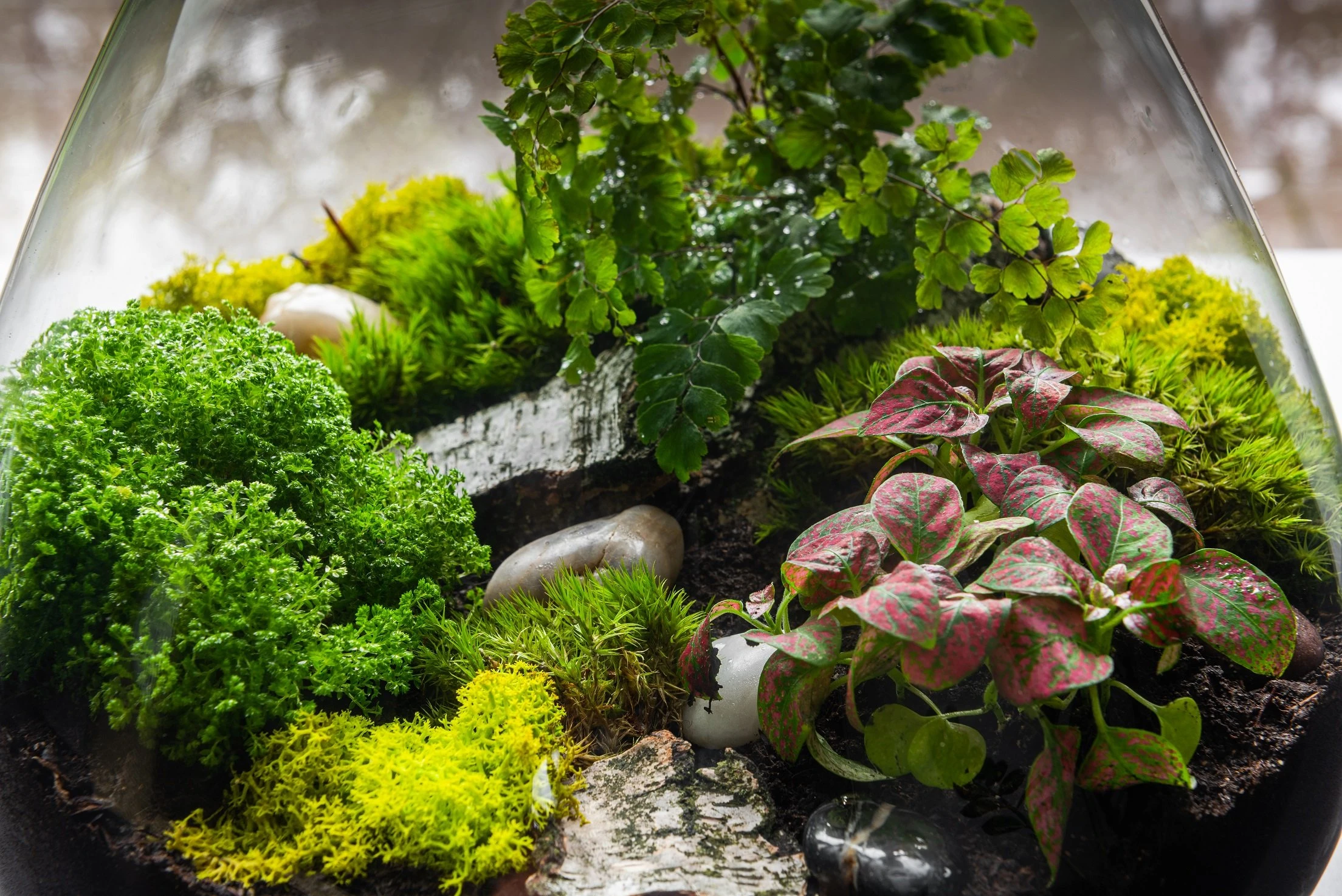reviewed by Christina Lopez
Different types of Terrarium Moss can use for beauty as decoration or housing for little reptiles and other aquatic animals. Many mosses are non-blossoming, tiny plants that develop thick bunches or green mats in obscure and clammy zones. Mosses have stems and leaves; however, they are bereft of any genuine roots. It is regular for leaves discovered on moss to be just a single cell thick.
Amazingly, these unique plants don’t make seeds. They are named sporophytes, implying they will start creating spores just after fertilization.
Contents
In this article, we’ll examine the most widely recognized mosses that you will probably experience in average patios or specialists’ terrariums.
Here are the various kinds of terrarium greenery
Live moss requires dampness and soil to thrive. These species can develop from spores rather than seeds, which is why planting is convenient. You can get the live moss at an affordable cost as compared to similar products.
Dried moss use as an art material. Numerous people utilize dried moss in tremendously unusual home activities, from bloom game plans to wreaths. Dried moss will remain in an idle state until rehydrated.
The moss is appealing to view and is planned explicitly with wireframes, planted dishes, and other art. It contains glycerin to keep it flexible and delicate.
Preserved moss utilize to portray moss that synthetic additives have repurposed for use with expressions and artworks. In contrast to dried moss, this moss is not alive and will not react to rehydration.
Indeed, you can purchase moss that isn’t greenery. Made of plastic, these non-natural items come as sheets or as “greenery covered” stones, similar to these.

Irish moss is nutritious, and it was once utilized as destitute food during the notorious Irish Potato Famine that occurred from 1846 to 1848. Currently, it has important medical advantages and uses to thicken milk and smoothies.
If you’re in the mindset to make exciting nurseries, Irish greenery seeds are exactly what you need. It makes a thick and rich rug of slender stems that will look splendid in many settings.
Cushion moss grows in the forest or wild places. It effectively makes its way into residential nurseries. Cushion moss forms green mossy balls, and growing them is easy.
If you need to develop moss effectively without agonizing over things becoming too arduous, you should think of growing cushion mosses.
Sheet moss uses to make flower solutions. They regularly structure cover-like mats on soil and rock. Sheet moss will flourish in the shade and endure some daylight, even though it isn’t prescribed to sparkle direct daylight onto them.
Spanish moss comes from a similar ordered family as delicious house plants and pineapples, which implies it’s, in fact, precisely a moss by any means. This perpetual spice takes its supplements from the air and garbage surrounding it.
This item is an incredible spot to begin if you like Spanish moss. It holds dampness, ideal for use with compartment plants, crate plants, and grower boxes. The result, when wholly developed, will add loads of style to your home. Indeed, even your pet reptiles will very much want to tunnel inside.
These are rock cherishing mosses that offer lovely groundcover. Gold moss serves different capacities, including restorative, consumable, and sufficiently aesthetic to give a makeover to your yard.
When completely developed, hair cap moss can surpass a nursery because they comprise wiry, intense shoots that grow to 40 cm long.
It is a group of mosses whose appearance resembles fluffy feathers. Its branches can develop somewhere in the range of 1 and 3cm long.
Terrarium Moss is another commonly known moss in the business world, and it is trusted and held in high respect. You can purchase 1 quart of moss which is not difficult to develop and doesn’t need exertion. Moreover, it is pesticide-free, which will make your gardening convenient.
Reindeer moss makes numerous petite and light branches, which fill in tufts fundamentally the same as pads. It can turn out to be genuinely fragile when dry yet holds its wipe-like design when rehydrated.
If you need to revitalize your home with solid reindeer moss that will keep going long after buy, then consider checking this item out. It has that signature light surface that reindeer moss is commonly known.
Mood moss is given its well-known name on account of the unmistakable appearance when holding entire dampness. It requires less water yet takes a long time to grow.
Here are the overall realities about greenery
To make a moss terrarium, you’ll require the accompanying fundamental items.
You will require some moss. You can purchase greenery on the web—and if you need moss that becomes outside of your environment, you’ll need to do as such.
You can undoubtedly utilize any glass compartment you need as long as you can put your hand inside—or for the more dynamic, you can fit some chopsticks inside to move things around.
Moss needn’t bother with the earth—you can develop it on a block if you need. You could undoubtedly utilize rock or whatever other substrate that the moss could connect itself. If you will use soil, peat-greenery gardening soil is an incredible choice since it’s exceptionally acidic. When moss isn’t developing on the bark of a tree or shakes, it flourishes with acidic soil.
Once you have your substrate and moss in the holder, the only thing left to do is keep the moss soggy.
Here are the steps for making a moss terrarium
You can choose a glass or plastic container, jar, beautifying holder, or box. The size relies upon your inclination. If you might want to house creatures in your terrarium, pick one that is fittingly estimated for the species and amount. The more modest the terrarium, the simpler it is to control moistness and keep it clean. Bigger compartments can hold more moss and make incredible highlights for tables and work areas.
If you plan to keep creatures in your terrarium, pick a glass one. Plastic is more affordable yet overheats effectively and can filter synthetic substances into water sources or even soften whenever left in direct daylight.
The taller and smaller the compartment, the less moss you will want to fit inside.
It would be best to keep creatures in terrariums with the correct length, width, and volume for their species. If you pick a tall aquarium, recall that it will be harder to clean and design.
You can utilize Spanish moss or other hanging moss species; however, earthly moss is better.
Purchase sand, shakes, or free soil for the lower part of your terrarium. This will help additional channel water, and you can style to accommodate your compartment’s look and size.
 |
 |
 |
 |

About Christina Lopez
Christina Lopez grew up in the scenic city of Mountain View, California. For eighteen ascetic years, she refrained from eating meat until she discovered the exquisite delicacy of chicken thighs. Christina is a city finalist competitive pingpong player, an ocean diver, and an ex-pat in England and Japan. Currently, she is a computer science doctoral student. Christina writes late at night; most of her daytime is spent enchanting her magical herb garden.
 |
 |
 |
 |
Check These Out
Get new FREE Gifts. Or latest free growing e-books from our latest works.
Disable Ad block to reveal all the links. Once done, hit a button below
 |
 |
 |
 |